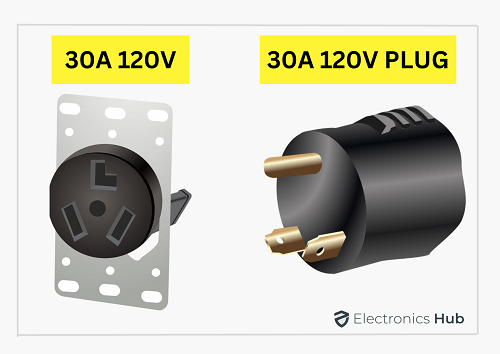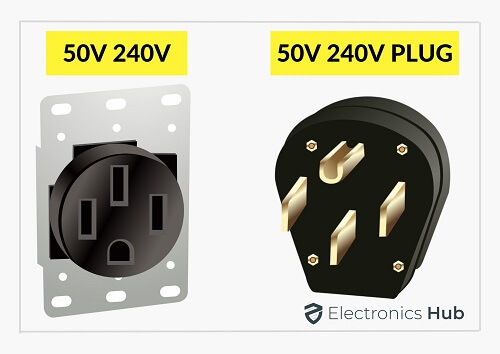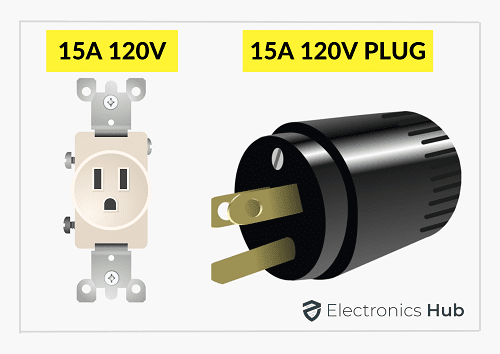In this guide, we will focus on the RV Electrical System and in particular, the RV Plugs. We will take a look at the different RV Plug Types.
Introduction
We take electricity in our homes for granted. Apart from severe emergencies (storms, floods, etc.), we have a stable supply of quality electricity in our homes. This is not the case in RVs. You are responsible to bring electricity to the RV. This can be through a bank of batteries combined with an inverter, solar panels on the roof, plugging into an RV Park or campground’s electrical outlets, or hookup a generator. Before understanding the different types of RV Plugs, let us briefly discuss the basics of the electrical system in a typical RV.
RV Electrical System
The electrical system in an RV is responsible for providing electricity to different parts of the RV so that you can plug all your electronic devices and electrical appliances. It is an important part of the whole “RV” experience as it is very hard to imagine life without electricity, even if it is on wheels. We can divide the electrical system in an RV into three categories. They are:
120V AC System 12V DC Automotive System 12V DC Cabin/Coach System
Let us briefly understand more about these three systems.
1. 120V AC System
This is the main electrical system in a residential setup. You get AC Mains electricity from your utility (which is 120V in North America). It reaches the main service panel. After that, you distribute it to all parts of your home and use it. How is it possible to get 120V AC in an RV? There are a couple of ways you can do this. The simplest way is to connect a proper plug to the electrical outlet at RV Parks, Campgrounds, or rest areas. If your RV has a proper AC electrical system, then chances are it has a provision to connect to such external outlets (shore power) using a plug (RV Plug, we will see more about this later). Once you connect your RV to the power, you can use it to run the refrigerator, AC, Microwave Oven, and other electrical appliances that run only on a 120V AC power supply. Another way to provide 120V AC to the RV is if you have a portable generator with you. You can hook up the same RV Plug to the generator, turn it on, and start using the electricity.
2. 12V DC Automotive System
You know there is at least one battery in your RV. The main car/RV battery is responsible to start the engine. Additionally, it will also provide 12V DC electricity to the lighting system, Radio, phone chargers, laptop chargers (you might need additional adapters or converters), etc. Once the RV engine starts, its alternator kicks in and recharges the battery. As the main purpose of this system is to start the engine, you should not use it without the RV running. You might drain the battery and cannot start the engine.
3. 12V DC Cabin/Coach System
There is another 12V DC electrical system in your RV. It consists of a separate battery (or multiple batteries) and provides electricity to the rest of the RV (apart from the main driving area). You can use this power to run 12V DC Systems such as coffee makers, blenders, etc. Additionally, this system also acts as the main supplier of electricity to the interior or awning lighting, water pumps, smoke detectors, etc.
Different RV Plug Types
Coming to the main event. We said earlier that when you are at a campsite or an RV Park, you can get shore power by connecting your RV’s electrical system to an electrical outlet at the location. So, how to connect the RV to the campground’s electrical system? You have to use the external plug of the RV. Here are the common RV Plug Types.
30A 120V Plug 50A 240V Plug 15A 120V Plug
When we say RV Plugs, we are referring only to the external plug that you have to plug into the electrical service at RV Park. When you connect this plug, you will receive 120V AC inside your RV. You can then use it to connect different appliances using electrical outlets in your RV. These outlets are usually 15A or 20A GFCI style outlets that you use in your homes. That said, let us now see more about the three RV Plug Types.
1. 30A 120V Plug
The 30A or 30-Amp plugs are very common in RVs. You can easily identify this plug by its unique 3-pin or 3-terminal design. The round prong on the top is the ground while the two straight prongs below are for hot and neutral. The term 30A (30-Amp) indicates that you can pull a maximum of 30 amperes using this plug. As this plug works with a 120V AC system, the maximum power you can use from this plug is 3,600 watts (120V × 30A = 3,600W). If you try to draw more than this, the breaker will trip. This value seems low but it is sufficient to power all your main electrical appliances (AC, Refrigerator, etc.).
2. 50A 240V Plug
If you have a slightly large motor home, then chances are it is equipped with a 50A or 50-Amp plug. The design of this plug is completely different from the previous 30A Plug. The main difference between 30A and 50A services is the 30-Amp service runs at 120V AC while the 50-Amp service runs at 240V AC. North America gets 240V by using two 120V systems. If you take a look at a typical 50A RV Plug, you will notice it has 4 prongs. The round prong on the top is as usual for the ground. The two parallel straight prongs below this are for two hot connections (remember 240V AC needs two hot systems). Then the last straight prong at the bottom is for neutral. The main advantage of the 50-Amp plug is the amount of power you can draw is significantly high. As it is a 240V system, with a maximum current draw of 50A, you have access to whooping 12,000 watts (240V × 50A = 12,000W). If you draw over 50A, the breaker will trip. The electrical system inside your RV must support this service. You need to make sure that you are using proper wire gauges so that they can handle the high currents.
3. 15A 120V Plug
This is not common nowadays but older RVs had the simple 15A or 15-Amp Plugs. There are a couple of reasons for this. You can plug this 15A plug into any residential outlet and start using the electricity. Next, some older RV Parks and camping grounds only had 15A service. In this case, you need the 15A Plug.
RV Plug Adapters
For instance, assume your RV has a 30A plug. You parked your motorhome at a campground to take a break. But the shore power has only a 50A outlet. The other way is also possible. You have a large RV with a 50A Plug but the RV Park has a 30A service. What to do in such situations? This is where RV Plug Adapters come in handy. You can get 50A to 30A as well as 30A to 50A adapters. One end is the male (that plugs into the shore power outlet) and the other end is the female (where you have to insert the RV Plug). There are two styles of RV Plug Adapters. A Dog Bone style adapter has a tiny wire between the male and female connectors. If you don’t want a huge and bulky adapter, you can go for a Hockey Puck-style adapter. This style of adapter has both male and female connectors on either side of a hockey puck-like adapter. It sits flush with the shore power outlet and you can connect the RV Plug at the other end. Make sure you have a couple of these adapters as you don’t know which park has what kind of outlets. We recommend the Dog Bone style adapter as they are rugged, durable, reliable, and safe.
What About Extension Cords?
Don’t even think about it. Never use extension cords to connect your RV Plugs. Extension cords are not designed to handle 50A of current. They are not safe and they might even start a fire. Extension cords are only for interior appliances, that are too small electrical devices.
Conclusion
Traveling long distances to a beautiful location on your RV is exciting. But the problem with motorhomes is, there is no proper supply of electricity. You have to rely on shore power while you park your RV at an RV Park or a campground. Portable Generators are an alternative, but they are expensive and not suitable for everyone. Another option is to have a bunch of batteries in your RV, convert it to AC, and start using the electricity. You can recharge the batteries using solar or other means. Regardless of the type of shore power, your RV must be equipped with a proper electrical system. In this guide, we saw the basics of an RV Electrical system and looked at different sources of electricity in an RV. Next, we saw different RV Plug Types. The two common types of RV Plugs are 30A 120V Plug and 50A 240V Plug. We also discussed the RV Plug adapters. If you feel we missed something or want us to add anything, do let us know in the comments section. We will try to add or amend it. It will not only help us but also other readers. Comment * Name * Email * Website
Δ








![]()